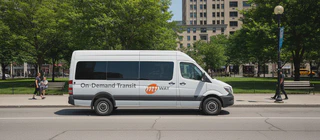On-Demand Transit Alternatives for the City of Mississauga
 Image credit: Reza Mahmoudi
Image credit: Reza Mahmoudi
Table of Contents
Overview
CLIENT
City of Mississauga, MiWay the municipal public transport agency
LOCATION
Mississauga, Ontario, Canada
Role
Designer, Planner
Markets
Transit & Rail
Transportation Market
Solutions
On-Demand Transit
Feasibility study
Uber Transit
Microtransit
Sustainability
Transportation Services
Regions
Regional Municipality of Peel
Our Client’s Challenge
Mississauga is a Canadian city in the province of Ontario. Located on the northwestern shore of Lake Ontario within the Regional Municipality of Peel, it borders Toronto to the east, Brampton to the north, Milton to the northwest, and Oakville to the southwest. With a population of 717,961 as of 2021, Mississauga ranks as the seventh-most populous municipality in Canada, the third-most in Ontario, and the second-most in the Greater Toronto Area (GTA), following Toronto itself.
From a transportation perspective, Mississauga is a mid-sized city whose public transit system is primarily operated by MiWay (Mississauga Transit). MiWay provides bus services across the city and connects with regional systems such as GO Transit and the TTC, operating more than 50 public bus routes.
Aligned with the MiWay 5 Transit Service Plan, and in response to inefficiencies in several fixed-route transit corridors, MiWay is exploring the replacement of underperforming routes with on-demand mobility services.
The first major step toward this transition involved launching a series of pilot projects in multiple zones across the city. These pilots aim to inform long-term decisions about expanding on-demand service based on operational outcomes and user feedback.
This project focused on several key tasks:
- Defining the specifications and characteristics of potential on-demand transit (ODT) scenarios and identifying the corresponding modeling requirements.
- Critically assessing and evaluating existing simulation platforms suitable for ODT analysis.
- Applying data-driven methods and simulation tools to develop operational solutions.
- Conducting two facilitated workshops to gather input from MiWay and other transit agencies, complemented by regular meetings with internal management teams.
Our Solution
For this project, we were granted access to nearly all datasets available from the transit agency, including TTS, GTFS, APC, AFC, and AVL data spanning almost two years. With this comprehensive data access, our team applied innovative, data-driven approaches to carry out the project through five major stages outlined in our proposed project pipeline.
 Figure: Project Pipeline.
Figure: Project Pipeline.
Analyzing Performance & Selecting Zones
Using a combination of TTS, GTFS, APC, AFC, and AVL data, along with user survey results, MiWay’s financial documents, and operational cost and benefit data, we conducted a comprehensive, network-level analysis of transit services. The objectives were to:
- Identify underutilized routes and analyze the demographic composition of riders (e.g., seniors, adults, and students).
- Assess service coverage across different operational periods (such as AM and PM peaks).
- Develop a travel time matrix between each traffic analysis zone (TAZ) and key destinations, including jobs, hospitals, schools, and grocery stores.
- Detect inefficient routes and segments and pinpoint the sources of inefficiency. These analyses allowed us to identify the zones within the city that were the most suitable candidates for transitioning from fixed-route service to on-demand mobility service.


 Figure: Applied novel utilization analysis approach.
Figure: Applied novel utilization analysis approach.
 Figure: Sample frequency and utilization analysis .
Figure: Sample frequency and utilization analysis .
 Figure: Sample segment level efficiency analysis .
Figure: Sample segment level efficiency analysis .
Developing Scenarios & Modelling Scenarios in PTV Visum
To develop possible scenarios for each zone:
- We analyzed household, population, trip, and transit-use characteristics for each zone.
- These analyses provided detailed insights into travel behavior, helping us understand demand patterns and service needs.
- The analyses were conducted using data from the 2022 Transportation Tomorrow Survey (TTS).
For each zone, three alternatives were evaluated:
- Implementing an on-demand transit service (with multiple possible configurations),
- Introducing a subsidized Uber Transit service, or
- Continuing to operate the existing fixed-route service
Each alternative was analyzed through four key steps:
- OD Trip Table Construction
- Trip (Request) Generation
- Parameter Setting
- Tour Planning All simulations were performed using PTV Visum for three selected zones, through which we calculated the values of preselected KPIs to identify the most suitable alternative for each zone.
Outcomes
- Scalable Data-Driven Framework: Developed a replicable framework for integrating on-demand mobility with fixed-route transit networks in complex urban environments.
- T-SPARK (Transit Service Performance Analysis and Redesign Kit): Created an analytical toolkit to evaluate and redesign transit services effectively at both route and segment levels.
- Operational Continuity: Ensured uninterrupted transit service during the transformation and pilot implementation phases.
- Cost-Effective Collaborative Strategies: Helped the transit agency identify opportunities to collaborate with third-party mobility providers, such as TNCs.
- Sustainability Benefits: Reduced greenhouse gas emissions, improved accessibility and equity across the network, enhanced community well-being, and lowered operational costs.
- Compliance and Leadership: Positioned MiWay as a forward-looking, responsible leader in providing modern and sustainable mobility services aligned with the goals of the next MiWay 5 plan.
Recommendations and Policy Implications
The findings carry several important implications for policy and planning.
- Adopt a zone-specific approach to service provision.
- Position ODT as a complement, not a substitute.
- Balance service quality with community impacts.
- Integrate ODT into network-level planning.